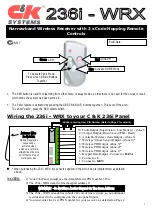
42
MDS iNET Series Reference Manual
05-2806A01, Rev. L
TIP:
Lower the
RTS Threshold
as the number of Remotes or overall over-the-air traffic increases. Using
RTS/CTS is a trade-off, giving up some throughput in order to prevent collisions in a busy over-the-air
network.
The
RTS Threshold
should be enabled and set with a value smaller than the
Fragmentation Threshold
described above. RTS forces the Remotes to request permission from the AP before sending a packet.
The AP sends a CTS control packet to grant permission to one Remote. All other Remotes wait for
the specified amount of time before transmitting.
•
RSSI Threshold (for alarm)
—Level (dBm) below which the received signal strength is deemed to have
degraded, and a critical event (alarm) is generated and logged. Under these conditions, the
PWR
lamp
flashes, and an SNMP trap is sent to the configured SNMP manager. [
0 to -120; -90
]
•
SNR Threshold (for alarm)
—Value (dB) below which the signal-to-noise ratio is deemed to have
degraded and a critical event is generated and logged. Under these conditions, the
PWR
lamp flashes,
and an SNMP trap is sent to the configured SNMP manager. [
0 to 40; Not Programmed
]
•
RF Hopping Format
—This option must be specified when the order is placed and cannot be modified
in the field by the user. Operation must be compliant with country-specific restrictions. The available
formats are:
•
ISM
: 902–928 MHz band (iNET only)
•
GSM
: 915–928 MHz band
•
SPLIT
: 902-907.5 and 915-928 MHz bands
•
CHANNELS
: 902–928 MHz, individual channels selectable within this range
•
Channel Config
(Only applies to iNET-II, or specifically programmed iNETs)
—Brings up the submenu
discussed in “Channel Config Menu” on Page 42.
•
Skip Zones
(Only applies to iNET in ISM mode. Editable at AP Only.)
—This selection brings up a sub-
menu discussed in “Advanced Configuration Menu” on Page 44.
•
Advanced Configuration
(AP Only)
—Allows the user to control settings on the AP that are used
during special circumstances. These parameters should not be modified unless specifically told to do
so
.
•
Auto Data Rate Configuration
(Remote only)
—This selection brings up a submenu as shown in
Figure 2-37. For the settings in this submenu to have any effect, the Data Rate menu item (Page 41)
must be set to
AUTO
.
•
Beacon Learning (iNET-II Remote only)
—Gives the ability to configure the Remote for faster scanning
and association. The Enabled option provides the standard iNET-II association behavior and is the
default selection. When Beacon Learning is set to
on assoc
, the user must configure a subset of the
AP’s channels on the Remote. This allows the Remote to scan the configured channels instead of the
entire frequency band. The
Disabled
option requires the user to configure the Remote with the same
channels as the AP. If the Remote’s configuration does not match, the Remote will not associate to
the AP.
[Enabled, Disabled, on assoc; Enabled]
2.5.2 Channel Config Menu
The Channel Configuration menu displays the utilization of channels in the 902–928 MHz range. This selec-
tion is available only on iNET-II or specially provisioned iNET units. The radio hops only on the channels
selected in this menu.
NOTE:
This menu changes when Beacon Learning is changed from
enabled
to
on assoc
. This applies to
iNET-II radios only. See Figure 2-34 on Page 43
.
Summary of Contents for MDS iNET Series
Page 12: ...x MDS iNET Series Reference Manual 05 2806A01 Rev L...
Page 159: ...05 2806A01 Rev L MDS iNET Series Reference Manual 147 Figure A 22 EDS Wizard Completion Screen...
Page 165: ...05 2806A01 Rev L MDS iNET Series Reference Manual 153 NOTES...
Page 166: ...154 MDS iNET Series Reference Manual 05 2806A01 Rev L NOTES...
















































